| Tennis Home |
| Introduction |
| 1 - The Basic Stroke |
| 2 - Proper Court Position |
| 3 - Defensive Strategy |
| 4 - Offensive Strategy |
| 5 - Serve and Return |
| 6 - Situation Tennis |
| Racquets and Stringing |
|
Tennis for Seniors Author- Richard M. Berger 09/15/2010 All rights reserved You are able to view this book because the author has given you a user name and password to gain access. Please do not copy the book or give your password to others. If you think you know someone who could benefit from this book, please send me their name and e-mail address and I will see that they get a password of their own. My e-mail is: tennis@bergerweb.net Have Fun, and enjoy tennis, the sport for a lifetime. |
| The Basic Stroke |
I said in the introduction that I would not try to improve your strokes. I intend to to stick to my word. I won't attempt to teach you the forehand or backhand ground stroke, or slice, or top-spin. Instead, I'll give you the fundamental principles of all tennis strokes. Much of your success will depend on understanding the basic components that make up the tennis stroke. On their website, the Brian Brothers divide "the tennis stroke" into eleven distinct parts:
- Split Step
- First Movement
- Hip Turn
- Grip Change
- Load Up
- Back Swing
- Accellerate
- Contact
- Wrist Roll
- Follow Through
- Recovery
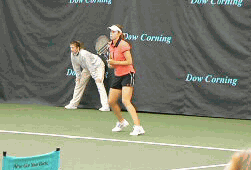
- The Split Step
- The Hip Turn
- The Swing
- The Follow Through
- The Recovery
Before reading further, watch carefully the animated picture of Laura Granville to the right. Then refer to the short clips of that animation as we go through the various parts of the tennis stroke.
Most instructors refer to the beginning of the stroke as "preparation", but in my opinion you should consider it a necessary part of every tennis stroke. You begin in the ready position, facing your opponent with your racquet held with the head at about chest level in front of you. Your legs start the process an instant before your opponent strikes the ball. As your opponent begins to bring his racquet forward, you push yourself up gently, and then land on the court with your feet about twice your sholuder width apart. You bend your knees to absorb the downward inertia of your body. In doing so, the energy stored in your calves and thighs will be at a maximum a fraction of a second after your opponent strikes the ball. This will help you to spring away in any direction necessary to intercept your opponent's shot.
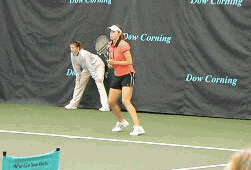 This move is referred to as the "split step", and for senior players, it is probably the single most ignored part of the stroke. Learning to do it on every stroke is sure to improve your tennis. Three things happen during the split step:
This move is referred to as the "split step", and for senior players, it is probably the single most ignored part of the stroke. Learning to do it on every stroke is sure to improve your tennis. Three things happen during the split step:
* When you land on the balls of your feet, you are correctly balanced to move in any necessary direction.
* Energy is stored in your legs and knees to give you better accelleration toward the proper hitting position.
* You are forced to concentrate on your opponent's racquet as he starts his swing so that you can time your split-step correctly.
Studies at Vic Braden's academy show that the above factors can give a player over 1/4 second advantage in moving to the ball. In 1/4 second, a medium paced ball (60 MPH) will travel 22 feet - the distance from the net to the service line.
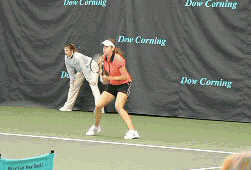 The next important part of the stroke (also considered by instructors to be part of preparation) is the hip turn. This gets you ready to move in the right direction. Even if you don't have to move your feet to get to the ball, the hip turn puts your body in the ideal position to strike the ball with power. When you turn your hips, your shoulders, arms, and racquet will also turn in the correct direction, and your legs, which are the biggest muscles in your body, will be supplying the power. The longer you have to react, the further your hips and upper body shoulder turn. Obviously when your opponent is closer to you when she hits the ball, there will be less time to react, but even then, a slight hip turn is essential to a clean stroke. Don't be tempted to turn just your shoulders to start your backswing. You will lose the power that can be supplied by your core muscles.
The next important part of the stroke (also considered by instructors to be part of preparation) is the hip turn. This gets you ready to move in the right direction. Even if you don't have to move your feet to get to the ball, the hip turn puts your body in the ideal position to strike the ball with power. When you turn your hips, your shoulders, arms, and racquet will also turn in the correct direction, and your legs, which are the biggest muscles in your body, will be supplying the power. The longer you have to react, the further your hips and upper body shoulder turn. Obviously when your opponent is closer to you when she hits the ball, there will be less time to react, but even then, a slight hip turn is essential to a clean stroke. Don't be tempted to turn just your shoulders to start your backswing. You will lose the power that can be supplied by your core muscles.
The next part, is the swing, because this is where you actually swing the racquet forward and strike the ball.
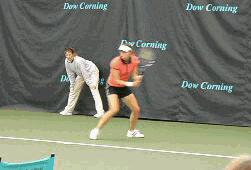 You want to contact the ball out in front of you, and freeze your eyes on the point of contact. In almost all cases, your racquet should contact the ball in front of any part of your body. This allows your eyes to follow the ball all the way to the racquet strings.
You want to contact the ball out in front of you, and freeze your eyes on the point of contact. In almost all cases, your racquet should contact the ball in front of any part of your body. This allows your eyes to follow the ball all the way to the racquet strings.
Imagine a ball coming toward you that will pass to your right. As the ball approaches, your eyes need only shift slightly to follow the ball. But as the ball is about to pass by your right side, you won't be able to keep sight of it without jerking your head quickly in a clockwise direction to follow it's path.
But if you strike the ball when it is still 12 - 18 inches in front of you, your eyes can remain focused on the ball until it hits your racquet, and your head need not turn at all. If you watch any pro closely, you will see that his head remains still long after the ball leaves his racquet.
Don't think your swing is finished when you hit the ball. If you want good directional and depth control, it's very important to follow through on your shot.
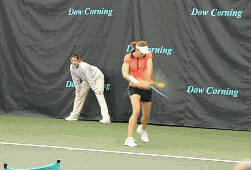 You want the racquet to be going in the direction you are aiming your shot, and to continue that path for as long as possible. Continue your stroke out toward your target, and then when your arm is fully extended, let the racquet coast to a stop. Unless you are hitting a slice, it should end up going high over your opposite shoulder. If you don't follow through, you will lose almost half of the potential power of the shot, and also cut down on your control. The longer your strings stay in contact with the ball, the more directional control you will have. If your racquet head is traveling 30 MPH when you strike the ball, the racquet will be in contact with the ball three times the distance that it would at 15 MPH, because not only is the racquet moving twice as far in the same amount of time, but the ball is also compressing more, and the strings are stretching more. How often have you watched a beginner at the net try to gently tap a falling lob over a net two feet in front of him, only to have it fall on his side of the net? That's because the velocity of the falling ball has more effect than the racquet, which is practically standing still. I hope that makes sense.
You want the racquet to be going in the direction you are aiming your shot, and to continue that path for as long as possible. Continue your stroke out toward your target, and then when your arm is fully extended, let the racquet coast to a stop. Unless you are hitting a slice, it should end up going high over your opposite shoulder. If you don't follow through, you will lose almost half of the potential power of the shot, and also cut down on your control. The longer your strings stay in contact with the ball, the more directional control you will have. If your racquet head is traveling 30 MPH when you strike the ball, the racquet will be in contact with the ball three times the distance that it would at 15 MPH, because not only is the racquet moving twice as far in the same amount of time, but the ball is also compressing more, and the strings are stretching more. How often have you watched a beginner at the net try to gently tap a falling lob over a net two feet in front of him, only to have it fall on his side of the net? That's because the velocity of the falling ball has more effect than the racquet, which is practically standing still. I hope that makes sense.
 Finally, to complete your stroke, you must recover back to your ready position. Professional tennis instructors don't consider this a part of the stroke, but most often call it "the recovery". Regardless of the name, it is still an important part of your routine. In doubles, for instance, if you had to take two steps forward and toward the center of the court to make a backhand volley, you would probably have to take a step or two back and toward the alley to be in a position to defend your part of the court. You will seldom be able to stay where you were when you hit the ball. Recovery doesn't necessarily mean going back to the point you started from. Rather, you need to move to a position on the court which allows you to cover the largest amount of the court into which your opponent may direct his shot. Ideally, you should reach this spot and have time to split-step as the opponent strikes the ball.
Finally, to complete your stroke, you must recover back to your ready position. Professional tennis instructors don't consider this a part of the stroke, but most often call it "the recovery". Regardless of the name, it is still an important part of your routine. In doubles, for instance, if you had to take two steps forward and toward the center of the court to make a backhand volley, you would probably have to take a step or two back and toward the alley to be in a position to defend your part of the court. You will seldom be able to stay where you were when you hit the ball. Recovery doesn't necessarily mean going back to the point you started from. Rather, you need to move to a position on the court which allows you to cover the largest amount of the court into which your opponent may direct his shot. Ideally, you should reach this spot and have time to split-step as the opponent strikes the ball.
Now, you may ask, "What should I do with all the time that's left over after doing all this stuff?" (hahahaha) Doubles is a fast-paced game. Most of the time you will have your hands full just keeping up with what you must do to keep the ball in play, but ocassionally, if you put up a lob or execute a great drop shot, you will have some time to actually think about strategy. This is usually the time when the better players shine. As you are striking the ball, your full attention must be on that tiny spot at the back side of the ball where your strings will make contact. Only after the ball has left your strings and disappeared from your vision can you focus on your opponents. (not the ball). Once you have determined which player will hit the ball, you need to shift your attention to that player's racquet. With a little experience, you can almost always anticipate where the ball is going by watching the face of your opponent's racquet. Even if she disguises her stroke, you still must watch the racquet in order to time your split-step properly. Then, with your legs loaded with potential energy, you will be able to spring off in the right direction, your focus completely on the ball.
Each of the above parts of the stroke gains you a little time, and gives you a better chance to set up for a good swing, and to move into the best position to defend your court. Don't leave out any of them, and you will be amazed at how much better your strokes can become.
Regardless of how much detail you use to break down your stroking pattern, the important thing is to use all the available time so that your shots give you an advantage over your opponent. Every moment of time that you don't utilize gives your opponent that much time to get an edge over you. Often, I see older players take a swing at the ball, and then stand practically still, not even getting their racquet back in the ready position. Watch any professional tennis player, and you will see that their feet are always moving, from the beginning to the end of each point. The next few chapters will give you plenty of things to do with your "spare time".
Drills to Improve your Strokes
- Have someone drop feed balls to you. See if you can time your split step so that your legs are loaded up as the ball leaves her strings. Shout "Split" just as she strikes the ball.
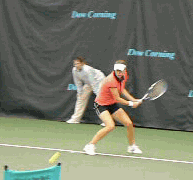 Same as above, but have your practice partner feed the balls randomly to your left or right, and try to see how quickly you can turn your hips in the correct direction.
Same as above, but have your practice partner feed the balls randomly to your left or right, and try to see how quickly you can turn your hips in the correct direction.- Look at the animation to the right, and notice how Laura Granville focuses on the point of contact long after the ball has left her racquet. Practice holding your head still, and keeping your eyes focused on the contact point. You should lose sight of the ball, and not regain sight of it until it is 15-20 feet from you. It helps to shout something like "Boom" just as your strings contact the ball. It also helps your concentration if you try to identify which shots hit in the exact center of your strings.
- Feed a ball to your practice partner and have her randomly hit lobs and drives. See how quickly you can shout "lob!" or "Drive!" correctly.
Mini Lesson - How to Recognize a Drop Shot
If you watch your opponent's swing very closely, you can detect a possible drop shot by observing the length of her back-swing. Very few people can hit an effective drop shot with a full backswing. Any time you see an abbreviated backswing, expect a drop shot, or at the very least, a shorter than usual drive.